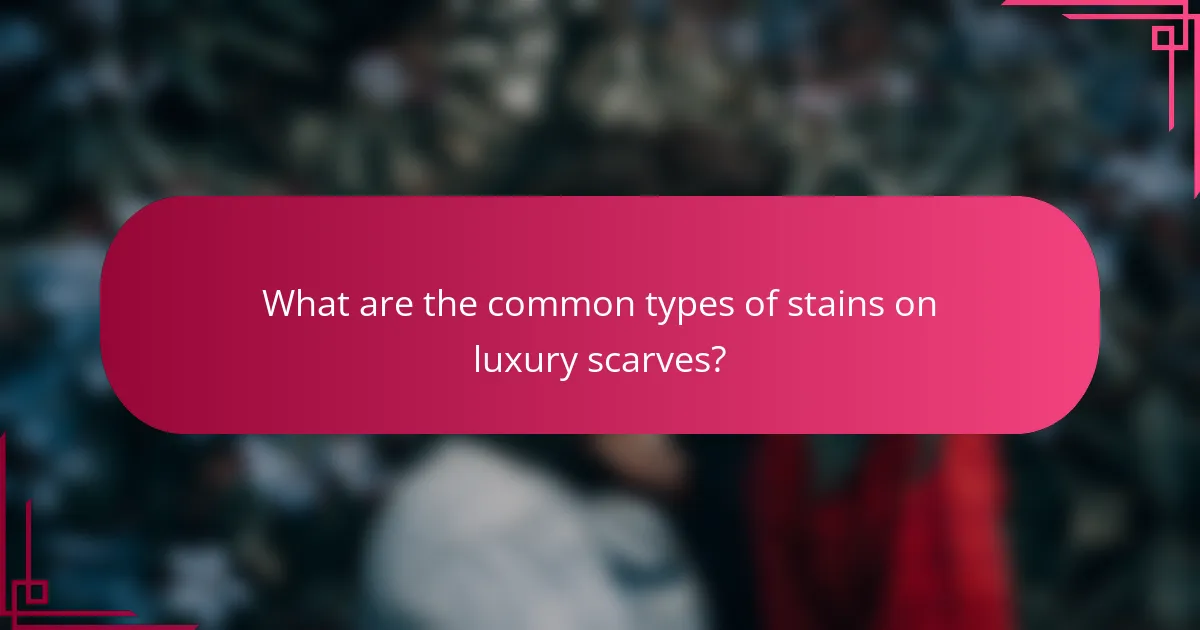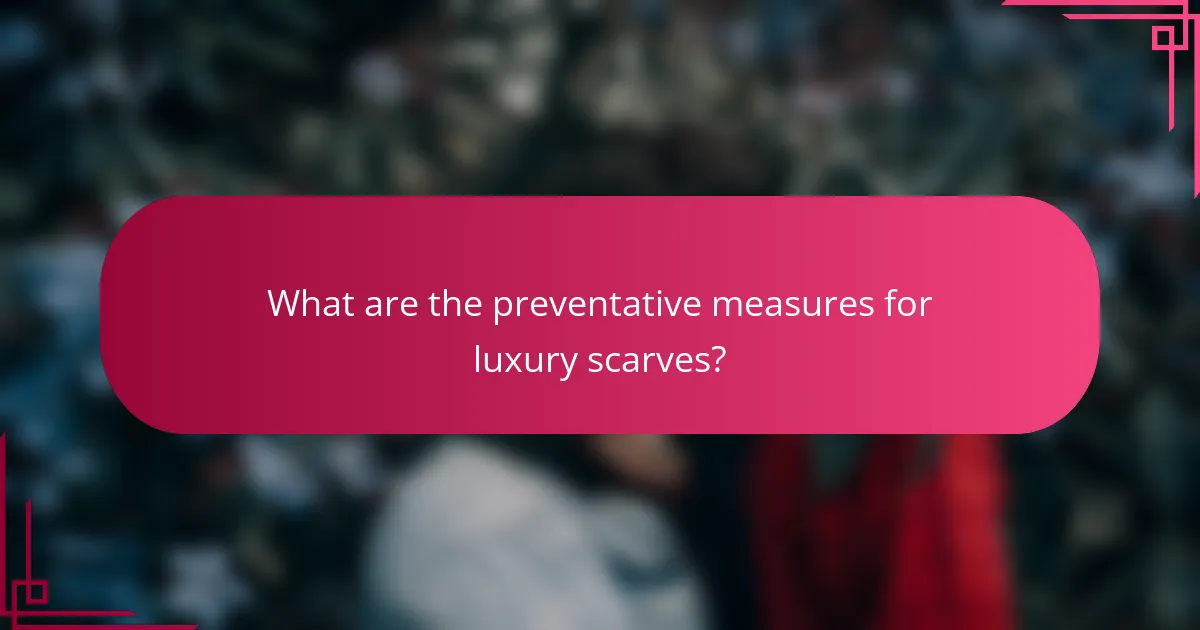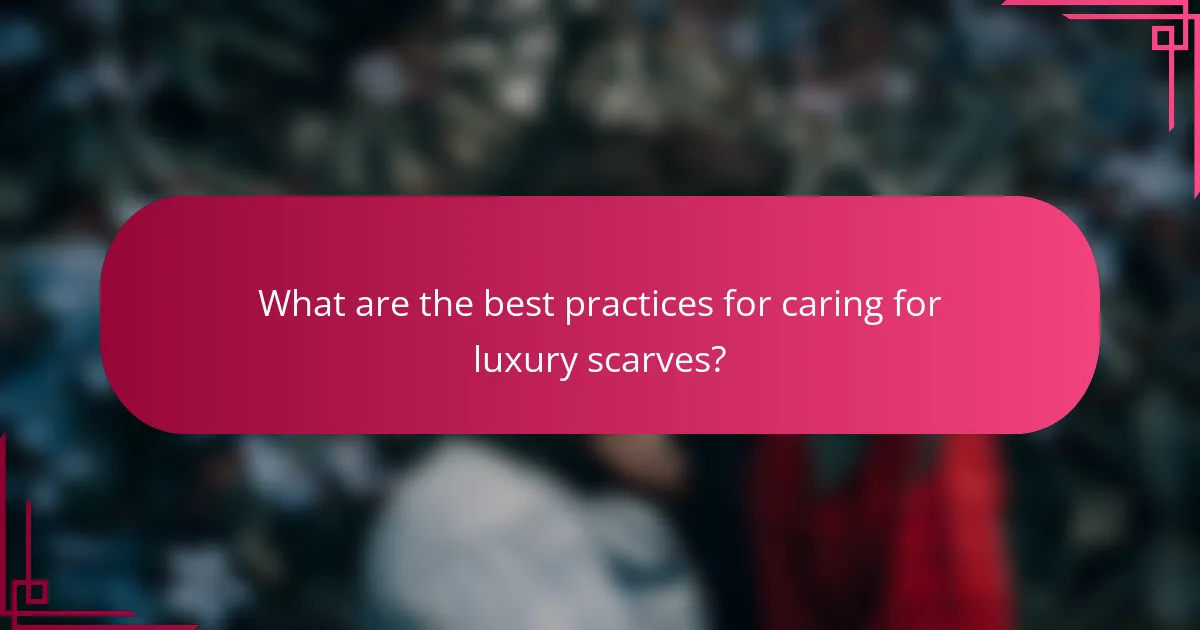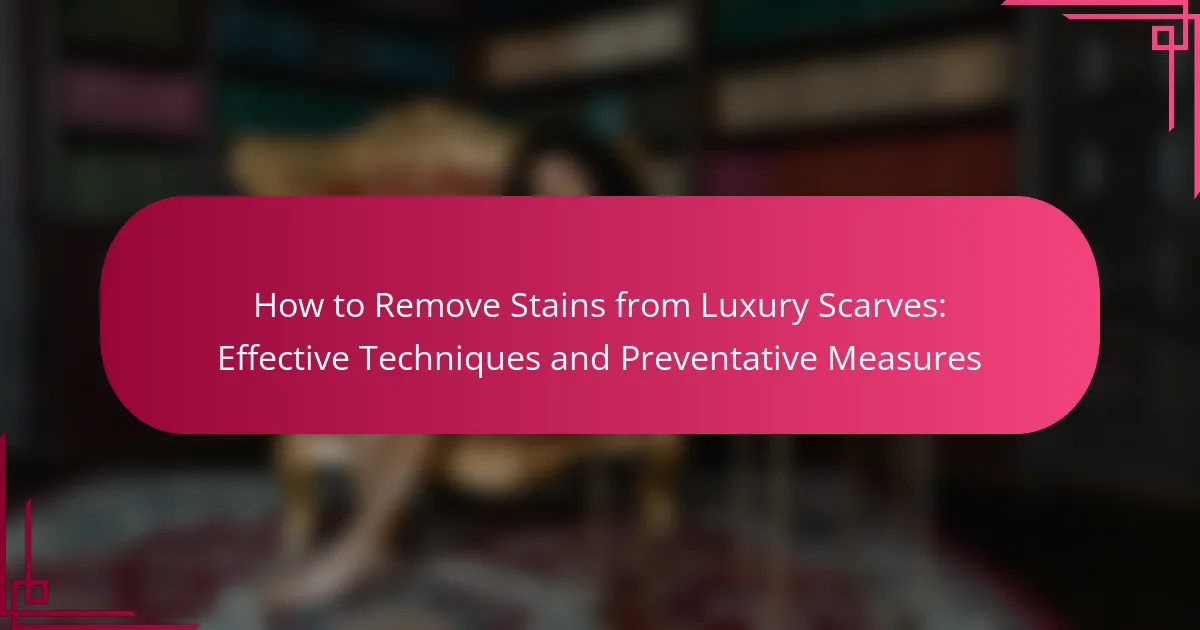Luxury scarves are susceptible to various types of stains, including oil, food, ink, sweat, and water stains. Each stain type requires specific cleaning methods to ensure effective removal and prevent damage. Preventative measures are crucial for maintaining the quality and appearance of luxury scarves, including proper storage, regular cleaning, and careful handling. Best practices for care involve storing scarves in cool, dry environments, using gentle cleaning techniques, and avoiding exposure to harsh elements. Understanding these aspects is essential for preserving the longevity and aesthetic of luxury scarves.

What are the common types of stains on luxury scarves?
Common types of stains on luxury scarves include oil stains, food stains, and ink stains. Oil stains often result from cosmetics or hair products. Food stains can occur from spills during meals. Ink stains are typically caused by pens or markers. Additionally, sweat stains may appear from skin contact. Water stains can occur from rain or spills, affecting the fabric’s appearance. Each type of stain requires specific cleaning methods for effective removal. Understanding these common stains helps in preventing damage to luxury scarves.
How do different fabrics affect stain removal?
Different fabrics significantly impact stain removal effectiveness. Natural fibers like cotton and linen tend to absorb stains, making them easier to treat. Synthetic fibers such as polyester are less absorbent, which can make stain removal more challenging. Delicate fabrics like silk require gentle cleaning methods to avoid damage. For example, silk can be easily stained but is sensitive to harsh chemicals. Wool can also absorb stains but is prone to shrinkage when washed improperly. The method of cleaning varies based on fabric type. A study from the Journal of Textile Science indicates that fabric composition influences stain absorption rates. Therefore, understanding the fabric type is crucial for effective stain removal.
What are the specific challenges of removing stains from silk scarves?
Silk scarves present unique challenges in stain removal due to their delicate fibers. The fabric’s sensitivity can lead to damage if treated improperly. Common stains like oil or wine can easily set into silk. Water-based cleaners may not be effective and can cause water spots. Heat can also worsen stains, making them harder to remove. Additionally, many commercial stain removers contain harsh chemicals that can harm silk. The dye in silk can bleed or fade with aggressive cleaning methods. Proper care requires knowledge of silk’s properties and appropriate cleaning techniques. These factors make stain removal from silk scarves particularly complex.
How does the material composition influence stain treatment?
The material composition of luxury scarves significantly influences stain treatment methods. Different fabrics react uniquely to various cleaning agents. For instance, silk is delicate and may require gentle, pH-balanced solutions. Cotton, on the other hand, is more durable and can withstand stronger detergents. Wool fibers can absorb moisture, making them prone to water stains, which need immediate attention. Synthetic materials often resist stains better but may require specific solvents for effective cleaning. Understanding these fabric properties helps in selecting the appropriate stain removal technique, ensuring effective treatment without damaging the scarf.
What are the most effective methods for removing stains?
The most effective methods for removing stains include immediate blotting, cold water rinsing, and using appropriate stain removers. Blotting helps absorb the stain without spreading it. Cold water rinsing prevents the stain from setting. Stain removers should be chosen based on the stain type. For example, enzyme-based removers work well on organic stains. Oxygen bleach is effective for color-safe cleaning. Always test any product on a hidden area first to avoid damage. These methods are supported by fabric care guidelines from cleaning experts.
How can household items be used for stain removal?
Household items can be effectively used for stain removal in various ways. Baking soda acts as a gentle abrasive and deodorizer. It can be mixed with water to form a paste for scrubbing stains. White vinegar is a natural disinfectant and can break down grease and odors. It can be applied directly to the stain or mixed with water. Lemon juice serves as a natural bleach and can lighten stains, especially on white fabrics. Rubbing alcohol can effectively remove ink stains when dabbed onto the affected area. Dish soap is effective for grease stains; mixing it with warm water creates a cleaning solution. Hydrogen peroxide can be used on tougher stains as a mild bleaching agent. These household items are readily available and provide effective solutions for stain removal.
What professional cleaning techniques are available?
Professional cleaning techniques include dry cleaning, steam cleaning, and spot cleaning. Dry cleaning uses chemical solvents to clean fabrics without water. This method is effective for delicate materials often found in luxury scarves. Steam cleaning employs hot steam to sanitize and remove dirt without harsh chemicals. Spot cleaning targets specific stains using specialized solutions. Each technique is designed to maintain the quality and integrity of luxury fabrics while effectively removing stains.

What are the preventative measures for luxury scarves?
Preventative measures for luxury scarves include proper storage, regular cleaning, and careful handling. Store luxury scarves in a cool, dry place away from direct sunlight. Use acid-free tissue paper to maintain their shape while stored. Regularly clean scarves according to the manufacturer’s instructions to avoid dirt buildup. Handle scarves with clean hands to prevent transferring oils or dirt. Avoid wearing scarves while eating or drinking to minimize stain risk. Protect scarves from exposure to perfumes or lotions, which can cause discoloration. These measures help maintain the quality and appearance of luxury scarves over time.
How can you protect luxury scarves from stains?
To protect luxury scarves from stains, apply a fabric protector spray designed for delicate materials. These sprays create a barrier against liquids and dirt. Ensure the scarf is clean and dry before application. Follow the manufacturer’s instructions for even coverage. Allow the spray to dry completely before wearing. Regularly reapply the spray every few weeks for ongoing protection. Additionally, store scarves in a cool, dry place away from direct sunlight. This prevents fading and potential stains from environmental factors.
What storage techniques help prevent stains?
Store luxury scarves in a cool, dry place to prevent stains. Use breathable fabric bags to minimize moisture exposure. Avoid plastic bags, as they can trap humidity. Fold scarves gently instead of hanging them, which can create creases. Keep scarves away from direct sunlight to prevent fading and discoloration. Use acid-free tissue paper to separate layers if stacking multiple scarves. Regularly check stored scarves for any signs of moisture or pests. Proper ventilation in the storage area helps maintain a stable environment.
How does regular maintenance contribute to stain prevention?
Regular maintenance significantly contributes to stain prevention by ensuring that dirt and debris do not accumulate on luxury scarves. Regular cleaning removes potential staining agents before they set in. For example, promptly addressing spills can prevent permanent discoloration. Additionally, routine inspections help identify wear or damage that could trap stains. Maintaining a proper storage environment, such as using breathable bags, further protects against dust and moisture. Research indicates that proactive care can extend the life of fabrics and reduce the likelihood of stains. Regular maintenance practices, therefore, play a crucial role in preserving the appearance of luxury scarves.
Why is it important to act quickly on stains?
Acting quickly on stains is crucial to prevent permanent damage to fabrics. Stains can set into materials over time, making them harder to remove. For example, food and drink stains can become ingrained in fibers within minutes. According to the American Cleaning Institute, treating stains promptly increases the chances of complete removal. Additionally, some substances can cause discoloration or degradation of the fabric if left untreated. Quick action minimizes the risk of these adverse effects. Thus, timely intervention is essential for maintaining the quality of luxury scarves.
What are the risks of delaying stain treatment?
Delaying stain treatment can lead to permanent discoloration and damage of the fabric. Stains can set into the fibers over time, making them harder to remove. For example, protein-based stains like blood or dairy can become more stubborn after a few hours. Oil-based stains can spread and create larger marks if not treated promptly. Additionally, certain stains may attract dirt and grime, worsening the appearance of the fabric. In some cases, the chemical composition of the stain can react negatively with the fabric over time. This can result in weakened fibers and reduced lifespan of the scarf. Immediate treatment is crucial for maintaining the quality and appearance of luxury scarves.
How can timely intervention improve stain removal success?
Timely intervention significantly improves stain removal success. Acting quickly prevents stains from setting into the fabric. For example, fresh stains are often easier to remove than older ones. The sooner a stain is treated, the less likely it is to bond with the fibers. Research indicates that most stains can be effectively removed within a few hours of occurrence. After this period, the stain may become permanent. Using appropriate cleaning methods immediately can enhance the effectiveness of the removal process. Therefore, prompt action is essential for maintaining the quality of luxury scarves.

What are the best practices for caring for luxury scarves?
The best practices for caring for luxury scarves include proper storage, gentle cleaning, and avoiding exposure to harsh elements. Store luxury scarves in a cool, dry place away from direct sunlight. Use a padded hanger or a dedicated drawer to maintain their shape. For cleaning, hand wash with cold water and mild detergent. Avoid wringing or twisting the fabric to prevent damage. Air dry flat on a clean towel to maintain texture. Regularly inspect for stains and treat them promptly with appropriate methods. These practices help preserve the quality and longevity of luxury scarves.
How do you clean luxury scarves safely at home?
To clean luxury scarves safely at home, hand washing is the best method. Fill a basin with lukewarm water and add a gentle detergent. Submerge the scarf in the water and gently agitate it. Avoid wringing or twisting the fabric to prevent damage. Rinse the scarf thoroughly with cool water until the detergent is completely removed. Lay the scarf flat on a clean towel to absorb excess water. Reshape the scarf and allow it to air dry away from direct sunlight. This method preserves the fabric’s integrity and color.
What are the recommended cleaning products for luxury fabrics?
The recommended cleaning products for luxury fabrics include gentle detergents, specialized fabric cleaners, and stain removers. Gentle detergents are formulated to clean without damaging delicate fibers. Brands like Woolite and The Laundress offer products specifically for luxury materials. Specialized fabric cleaners target specific types of fabrics, such as silk or cashmere. Stain removers should be pH-balanced and free from harsh chemicals. Products like OxiClean MaxForce or Zout are effective yet gentle. Always test cleaning products on a small, inconspicuous area first. This ensures that the fabric’s color and texture are not affected.
How can you test for colorfastness before cleaning?
To test for colorfastness before cleaning, use a damp white cloth or cotton swab. Dab a small, inconspicuous area of the fabric gently. If color transfers to the cloth, the fabric may not be colorfast. This method helps identify potential bleeding issues. Testing ensures the cleaning process will not damage the item. Colorfastness is crucial for maintaining the integrity of luxury scarves.
What tips can help maintain the quality of your luxury scarves?
To maintain the quality of luxury scarves, store them properly. Use a cool, dry place away from direct sunlight. Avoid folding to prevent creasing; roll them instead. Clean them gently, following care labels for washing instructions. Use a mild detergent for delicate fabrics. Dry cleaning is recommended for silk and cashmere. Handle them with clean hands to prevent oils from transferring. Rotate usage to minimize wear and tear. Regularly inspect for damage and address issues promptly.
How should you handle and store scarves to avoid damage?
Handle scarves gently to avoid damage. Always hold them by the edges to prevent stretching. Avoid pulling or tugging on the fabric. When storing, fold scarves neatly instead of hanging them. Use acid-free tissue paper to prevent creases. Store in a cool, dry place away from direct sunlight. This prevents fading and fabric deterioration. Natural fibers like silk and wool require special care. Ensure they are clean before storage to avoid stains. Following these practices extends the life of luxury scarves.
What are common mistakes to avoid when caring for luxury scarves?
Common mistakes to avoid when caring for luxury scarves include improper washing techniques. Many people use hot water, which can damage delicate fabrics. Others may use harsh detergents that can fade colors. Not checking care labels is another frequent error. Each scarf has specific cleaning instructions that should be followed. Storing scarves improperly is also a mistake. Folding them can create creases, while hanging can stretch them out. Ignoring stain treatment promptly can lead to permanent damage. Addressing stains quickly with the right method is crucial. Finally, neglecting regular maintenance can diminish the scarf’s quality over time. Regularly inspecting for wear and tear can help maintain its condition.
What troubleshooting tips can help with stubborn stains?
Use a stain remover specifically designed for the fabric type. Test the remover on a hidden area first. Blot the stain gently with a clean cloth, avoiding rubbing. Use cold water for most stains, as hot water can set them. For oil-based stains, sprinkle baking soda to absorb the oil before treating. Soak the scarf in a mixture of water and white vinegar for stubborn stains. Rinse thoroughly after treatment to remove any residue. Repeat the process if the stain persists, as some stains require multiple treatments.
The main entity of this article is luxury scarves, focusing on effective techniques for stain removal and preventative measures. It covers common types of stains, such as oil, food, and ink, and discusses how different fabrics affect stain treatment. The article provides insights into the challenges of cleaning delicate materials like silk, the importance of timely intervention for stain removal, and the best practices for caring for luxury scarves to maintain their quality. Additionally, it explores the use of household items and professional cleaning techniques, as well as storage methods to prevent stains and damage.
